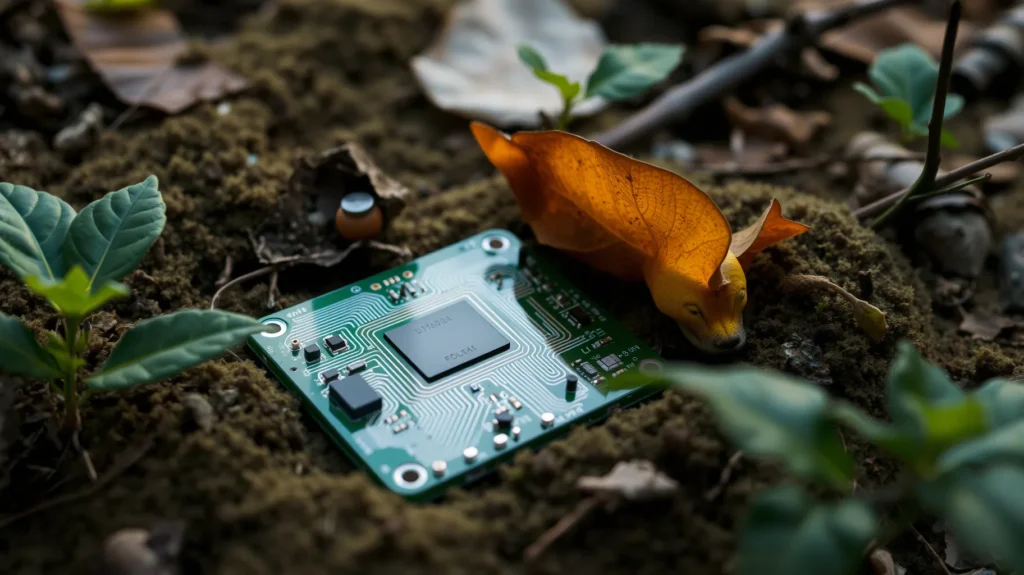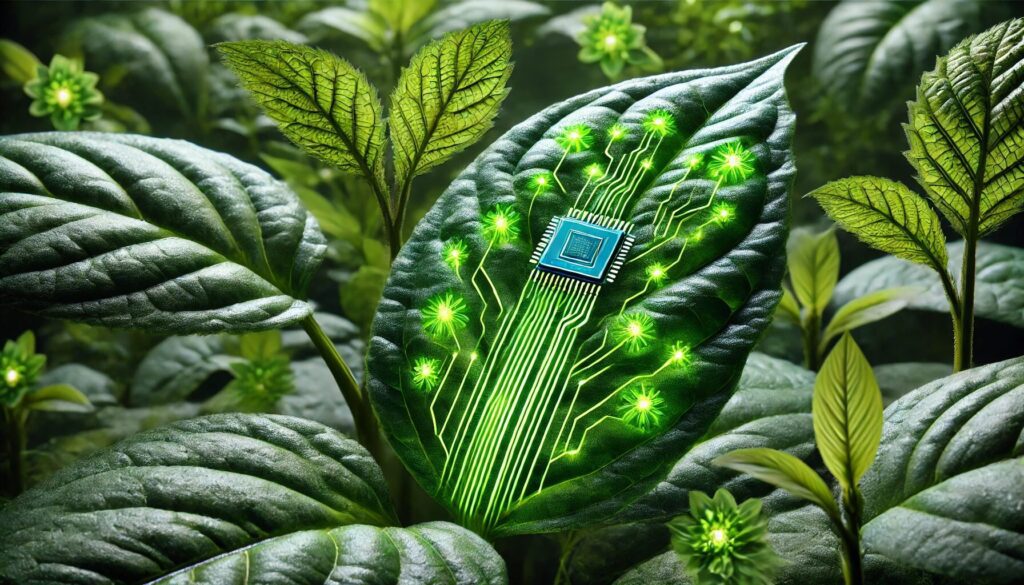
The demand for smarter, faster, and more efficient devices seems never-ending. But as exciting as this growth is, it comes with a price—the mountain of electronic waste that keeps piling up. As we push for a more sustainable world, one intriguing solution has emerged: biodegradable electronics. Could these eco-friendly devices reshape the future of AI hardware? Let’s dive into this revolutionary concept and explore how it might be the key to greener tech.
The Problem with E-Waste
The amount of e-waste generated globally is staggering. According to reports, we produce over 50 million tons of electronic waste each year, and the number is only rising. Most of this waste includes harmful materials like plastics, heavy metals, and non-biodegradable components. As we continue to embrace artificial intelligence (AI), the hardware needed to support these systems will likely increase too, contributing to the ever-growing e-waste crisis. Traditional electronics are not built to break down naturally, which leads to long-term environmental problems. This is where biodegradable electronics come into play.
What Are Biodegradable Electronics?
Imagine if your smartphone, laptop, or even the chips that power AI systems could naturally decompose once they’ve served their purpose. Sounds futuristic, right? But it’s not as far-fetched as it seems. Biodegradable electronics are made from organic materials or other substances that can break down naturally over time. Materials like cellulose, silk proteins, or special polymers are often used to create devices that, once discarded, can return to the Earth without leaving behind harmful residues.
How Biodegradable AI Hardware Works
The core idea behind biodegradable AI hardware lies in replacing traditional materials with environmentally friendly alternatives. Instead of silicon-based chips and toxic metals, these eco-conscious devices are made from biocompatible materials that perform well and break down under natural conditions. Researchers have developed circuits using materials like transient metals, which dissolve in water, and substrates made from wood pulp or other plant-based materials.
For AI systems, the challenge is maintaining performance and durability while using these unconventional materials. The good news is that scientists are making breakthroughs every year. Flexible biodegradable circuits are being tested, and they show promise in supporting everything from AI algorithms to advanced machine learning systems. This innovation could reshape the way we design hardware, making it possible for AI systems to be both powerful and sustainable.
Benefits of Biodegradable Electronics in AI Hardware

Switching to biodegradable materials isn’t just about reducing waste. There are several compelling reasons why sustainable AI hardware could change the tech industry for the better:
1. Reducing Environmental Impact
One of the most obvious benefits is the reduced environmental footprint. Traditional electronic components can take hundreds or even thousands of years to break down. In contrast, biodegradable electronics can decompose within months or years, minimizing the long-term environmental damage.
2. Energy-Efficient Manufacturing
Creating AI hardware from biodegradable materials could also lead to more energy-efficient manufacturing processes. Since many organic materials can be sourced naturally, they often require less energy to produce compared to conventional metals and plastics.
3. Supporting Circular Economy
Biodegradable electronics fit perfectly into the concept of a circular economy, where materials are continually reused or returned to the Earth. This not only cuts down on waste but also promotes resource efficiency, a crucial aspect as we strive for sustainable development.
4. Safer Disposal and Recycling
Unlike traditional electronics that can leach toxic chemicals into the soil or water, biodegradable electronics offer a safer solution for disposal. They don’t release harmful substances during decomposition, which is a massive step toward cleaner landfills and recycling facilities.
Challenges Facing Biodegradable AI Hardware

As promising as this innovation sounds, biodegradable AI hardware is not without its challenges. While the concept is gaining traction, there are several obstacles that researchers and engineers must overcome before we see widespread adoption.
1. Durability vs. Biodegradability
One of the most significant hurdles is finding the balance between durability and biodegradability. AI systems, especially in high-performance environments, require robust hardware capable of withstanding intense processing demands. Ensuring that these biodegradable materials are durable enough to support complex AI computations while still breaking down efficiently after their lifespan is no small task.
2. Scalability
Another challenge is scaling production. Most biodegradable electronics are still in the research phase, meaning mass production is not yet feasible. Until manufacturers can scale up production while keeping costs down, biodegradable AI hardware will likely remain a niche solution.
3. Public Perception and Adoption
Finally, there’s the question of whether consumers and businesses will fully embrace these new technologies. Many people are accustomed to the reliability of traditional electronics, and making the shift to biodegradable versions might take time. However, with growing awareness of environmental issues, there’s hope that the public will eventually recognize the benefits of sustainable AI hardware.
Current Innovations and Research in Biodegradable AI Hardware
Despite the challenges, researchers worldwide are working tirelessly to push biodegradable electronics forward. Some of the most exciting developments include:
1. Transient Electronics
These are electronic devices designed to dissolve in water or under specific environmental conditions. They’ve already been used in medical implants, but scientists are now exploring their use in AI chips and other computing hardware.
2. Silk-Based Circuits
Silk proteins, known for their strength and flexibility, are being explored as potential materials for biodegradable circuits. Researchers are experimenting with using silk films as substrates for AI processors, which could allow devices to perform complex computations before breaking down naturally.
3. Plant-Based Sensors
Some research teams are focusing on developing plant-based sensors that could be used in AI systems. These sensors would not only reduce the need for toxic materials but also be fully compostable, contributing to a cleaner tech ecosystem.
Future Potential of Biodegradable Electronics in AI Hardware

So, what does the future hold for biodegradable AI hardware? As we look ahead, it’s clear that these technologies could do more than just reduce e-waste. They might even transform industries, enable new types of AI applications, and create a more sustainable tech economy. Let’s break down some of the exciting possibilities that could unfold as biodegradable electronics become more mainstream.
Revolutionizing Consumer Electronics
Picture this: your smartphone, smart speaker, or laptop doesn’t just serve you for a few years and then sit in a landfill for centuries. Instead, it’s designed with a planned obsolescence that’s eco-friendly, naturally breaking down after you’re done with it. This shift could change how companies approach product life cycles, encouraging a more responsible way of consuming tech.
Consumer demand for sustainable electronics is increasing, especially with heightened awareness of environmental issues. As more consumers opt for biodegradable devices, companies will likely follow suit, creating a competitive market that prioritizes eco-friendly alternatives. Tech giants could eventually face pressure to incorporate biodegradable components into their flagship products, making these materials a standard in the industry.
Biodegradable AI in Healthcare
AI is already revolutionizing healthcare, from diagnostics to personalized treatments. But biodegradable electronics could take it a step further. Imagine biodegradable medical devices that work alongside AI, such as sensors or implants designed to monitor a patient’s health for a set period, then safely dissolve within the body or environment after they’ve done their job.
These devices could lead to fewer surgical removals of implants, reducing patient risk and hospital costs. Furthermore, biocompatible sensors paired with AI could continuously monitor health metrics, offering doctors real-time data to predict issues before they become critical. This combination of AI and eco-friendly materials would reduce medical waste and improve patient outcomes, making healthcare more sustainable and efficient.
Green AI and Smart Cities
The concept of smart cities—urban areas using AI to manage resources efficiently—is rapidly gaining momentum. However, current smart city infrastructure relies on energy-intensive systems and traditional electronics, both of which contribute to waste. Enter biodegradable AI hardware.
Imagine citywide sensors and IoT devices that power everything from traffic management to energy distribution, all made from biodegradable materials. When these devices reach the end of their life cycle, they don’t add to the waste problem. They decompose harmlessly, leaving no toxic residues behind. This could mark a turning point in the development of green AI, making smart cities even smarter by being sustainable.
Additionally, biodegradable AI sensors could be deployed for environmental monitoring. These sensors would track pollution levels, monitor wildlife, or even measure soil health. Once their job is done, they’d break down naturally, reducing the need for costly and complex disposal systems.
Impact on the Tech Supply Chain
A shift toward biodegradable electronics will also transform the tech supply chain. Traditional electronic components rely on mining and processing metals, which can be energy-intensive and damaging to the environment. Biodegradable electronics, on the other hand, could use renewable materials like plant-based polymers or biodegradable metals. This change would reduce the demand for mined materials and lower the overall carbon footprint of manufacturing.
Additionally, a circular supply chain built around biodegradable electronics would focus on designing products that can be repurposed, repaired, or broken down for reuse. This could lead to closed-loop systems in manufacturing, where nothing goes to waste, making the tech industry more sustainable from top to bottom.
Applications in Wearable Technology
Wearable tech, such as fitness trackers, smartwatches, and even AI-powered wearables, is becoming increasingly popular. However, these devices tend to have short lifespans, and when they’re discarded, they contribute to the growing e-waste problem. With biodegradable electronics, we could create wearable devices that are both high-tech and eco-friendly.
For instance, a biodegradable fitness tracker could monitor your health metrics and be composted after a few years of use, leaving no harmful trace. Biodegradable sensors woven into smart fabrics could provide real-time data for athletes or patients, offering performance feedback and health monitoring without the long-term environmental cost.
Challenges on the Horizon
While the future of biodegradable AI hardware looks promising, there are still significant obstacles to overcome before it becomes mainstream.
1. Cost
Currently, biodegradable electronics are more expensive to produce than traditional electronics. As research and development continue, costs may come down, but for now, the price point remains a barrier to widespread adoption. Companies will need to strike a balance between sustainability and affordability to make these devices accessible to the average consumer.
2. Limited Performance
Though progress is being made, biodegradable electronics often don’t perform as well as their non-biodegradable counterparts. For AI hardware, which demands high computational power, finding biodegradable materials that can handle these processing loads while remaining eco-friendly is a huge challenge. Future innovations will need to focus on enhancing the performance and longevity of these materials to match traditional electronics.
3. Regulatory and Industry Standards
There are currently few regulations governing the production and use of biodegradable electronics. As this technology advances, governments and industries will need to create standards and guidelines to ensure these devices are safe, effective, and truly sustainable. Additionally, ensuring that biodegradable AI hardware meets the same security and privacy standards as traditional devices will be critical.
The Role of Governments and Policy Makers
Governments around the world have already started taking steps to reduce e-waste through recycling programs and stricter regulations on electronic manufacturing. As biodegradable electronics become more viable, policymakers could play a pivotal role in encouraging their adoption.
Incentives for Eco-Friendly Tech
Governments could offer tax incentives or subsidies to companies that invest in biodegradable technologies. This would encourage more businesses to explore eco-friendly options and push the tech industry toward sustainable practices. Additionally, creating regulations that mandate the use of biodegradable materials in certain industries—like consumer electronics—could hasten the adoption of sustainable AI hardware.
Raising Public Awareness
Educational campaigns could also help raise awareness about the importance of biodegradable electronics. As consumers become more aware of the environmental impact of their tech choices, demand for sustainable products will likely increase. Policymakers, environmental groups, and tech companies could work together to ensure consumers understand the benefits of choosing biodegradable devices.
The Ethical Side of Biodegradable AI
There’s another layer to consider: the ethical implications of creating AI systems with biodegradable hardware. Many of the materials used in today’s electronics are sourced from regions where mining conditions are harsh, and environmental degradation is common. Switching to biodegradable materials could reduce reliance on these practices, making tech production more ethically responsible.
Moreover, as AI continues to integrate into more aspects of society, ensuring that its hardware is sustainable and ethically produced will become increasingly important. The shift to biodegradable AI hardware could help reduce the environmental and social impact of tech manufacturing, making the entire industry more aligned with ethical principles.
Conclusion: Biodegradable Electronics and the Path to Sustainable AI
As we wrap up our exploration into biodegradable electronics, one thing is clear: this innovative technology has the potential to change the future of AI hardware and the entire tech industry. By embracing biodegradable materials, we can create AI systems that not only power incredible advancements but also respect the planet. Though challenges remain, the promise of sustainable AI is within reach.
Biodegradable electronics represent more than just a technological advancement; they symbolize a fundamental shift in how we approach the intersection of tech and sustainability. As we continue to innovate, it’s crucial that we consider the environmental impact of our devices and work toward a future where technology and nature can coexist harmoniously. The future of AI hardware just might be green.
FAQs
What are biodegradable electronics?
Answer: Biodegradable electronics are electronic devices and components designed to naturally decompose after their intended lifespan, minimizing environmental impact. They are made from materials that can break down into non-toxic byproducts when exposed to environmental conditions like moisture, heat, and microbial activity. This innovative approach aims to reduce electronic waste (e-waste) and promote sustainability in the electronics industry.
How do biodegradable electronics contribute to sustainability?
Answer: Biodegradable electronics address the growing concern of e-waste, which poses significant environmental and health risks due to toxic materials. By decomposing naturally, these electronics reduce landfill accumulation and prevent harmful substances from leaching into soil and water sources. This sustainable approach conserves resources by utilizing renewable materials and promotes a circular economy by potentially integrating with biodegradable packaging and products.
Can biodegradable electronics be used in AI hardware?
Answer: Yes, biodegradable electronics have the potential to be integrated into AI hardware. Researchers are exploring the use of biodegradable materials in sensors, circuits, and other components essential for AI devices. While currently most suitable for low-power and transient applications, advancements in material science may enable their use in more complex AI hardware, contributing to more sustainable AI systems.
What materials are used in biodegradable electronics?
Answer: Common materials include:
- Biodegradable Polymers: Such as polylactic acid (PLA) and polycaprolactone (PCL).
- Natural Fibers: Like cellulose, silk, and chitin.
- Dissolvable Metals: Magnesium, zinc, and iron that can corrode safely.
- Organic Semiconductors: Materials like indigo or certain proteins that can conduct electricity.
These materials are chosen for their ability to perform electronic functions while being environmentally friendly.
What are the benefits of using biodegradable electronics in AI hardware?
Answer: Benefits include:
- Environmental Impact Reduction: Minimizes e-waste and pollution.
- Resource Conservation: Uses renewable and abundant materials.
- Health Safety: Reduces exposure to toxic substances during disposal.
- Regulatory Compliance: Meets increasing environmental regulations and standards.
Implementing biodegradable components in AI hardware supports sustainable development goals and corporate social responsibility initiatives.
What are the challenges and limitations of biodegradable electronics?
Answer: Challenges include:
- Performance Limitations: Biodegradable materials may not yet match the performance of traditional electronics in terms of speed, durability, and longevity.
- Manufacturing Complexity: New processes and technologies are required to produce biodegradable components at scale.
- Cost Factors: Currently, biodegradable materials and manufacturing methods can be more expensive than conventional options.
- Stability Issues: Ensuring that devices remain functional until the end of their intended lifespan without premature degradation.
Ongoing research aims to overcome these hurdles to make biodegradable electronics more viable for widespread use.
Are there any examples of biodegradable electronic devices?
Answer: Yes, examples include:
- Biodegradable Sensors: Used in medical applications for temporary monitoring, eliminating the need for surgical removal.
- Transient Electronics: Devices designed to perform a function for a limited time before dissolving.
- Eco-Friendly Packaging Electronics: Biodegradable RFID tags and circuits embedded in packaging materials.
These applications demonstrate the potential of biodegradable electronics in various fields, including healthcare and logistics.
How does the use of biodegradable electronics impact the environment?
Answer: The use of biodegradable electronics significantly reduces environmental pollution by:
- Decreasing E-Waste: Limiting the accumulation of non-degradable electronic devices in landfills.
- Preventing Toxic Leachate: Avoiding the release of hazardous substances into ecosystems.
- Reducing Carbon Footprint: Lowering emissions associated with the production and disposal of electronics.
This positive environmental impact supports efforts to mitigate climate change and preserve natural resources.
What is the future outlook for biodegradable electronics in AI hardware?
Answer: The future is promising, with ongoing advancements expected to:
- Enhance Material Performance: Improved biodegradable materials that can meet or exceed traditional electronic standards.
- Expand Applications: Broaden the use of biodegradable components in various AI devices, including wearables and sensors.
- Integrate with Emerging Technologies: Combine with technologies like 5G and edge computing for more sustainable AI solutions.
- Drive Industry Adoption: Increased awareness and regulatory support may lead to wider industry acceptance and implementation.
As research progresses, biodegradable electronics could become a cornerstone in the development of sustainable AI hardware.
How do biodegradable electronics compare to traditional electronics in terms of performance?
Answer: Currently, biodegradable electronics may not match traditional electronics in all performance aspects:
- Electrical Conductivity: Generally lower but improving with material innovation.
- Durability: Designed for temporary use, which may limit long-term applications.
- Processing Speed: May not reach the high speeds of silicon-based components yet.
However, for certain applications where long-term durability is not essential, biodegradable electronics offer sufficient performance with the added benefit of environmental sustainability.
What role can biodegradable electronics play in reducing the carbon footprint of AI hardware?
Answer: They can reduce the carbon footprint by:
- Lowering Energy Consumption: Manufacturing biodegradable materials may require less energy.
- Minimizing Waste Processing: Reducing the need for energy-intensive recycling or waste management processes.
- Encouraging Sustainable Practices: Promoting the use of renewable resources and environmentally friendly manufacturing techniques.
Collectively, these factors contribute to a more sustainable lifecycle for AI hardware.
Are tech companies investing in biodegradable electronics for AI?
Answer: Some tech companies and startups are exploring biodegradable electronics:
- Research Investments: Funding university and corporate research into sustainable materials and components.
- Collaborations: Partnering with material scientists and engineers to develop prototypes.
- Pilot Programs: Testing biodegradable components in limited product lines or applications.
While widespread commercial adoption is still emerging, interest is growing due to environmental concerns and consumer demand for sustainable products.
What advancements are needed for biodegradable electronics to be widely adopted in AI hardware?
Answer: Necessary advancements include:
- Material Innovation: Developing biodegradable materials with enhanced electrical properties and stability.
- Manufacturing Techniques: Creating scalable and cost-effective production methods.
- Standardization: Establishing industry standards for performance and decomposition rates.
- Regulatory Support: Policies that incentivize sustainable practices and the use of biodegradable materials.
These developments will help overcome current limitations and encourage broader industry adoption.
How can consumers and industries support the shift towards biodegradable electronics?
Answer: Support can be provided by:
- Demanding Sustainable Products: Encouraging manufacturers to develop eco-friendly options.
- Investing in Research: Funding and supporting research initiatives focused on biodegradable technologies.
- Adopting Sustainable Practices: Industries can integrate biodegradable components into their products and supply chains.
- Education and Awareness: Promoting the benefits of biodegradable electronics to foster consumer acceptance.
Collective efforts from consumers, industries, and policymakers can drive the transition towards sustainable AI hardware.
What is the potential impact of biodegradable electronics on the future of AI and technology?
Answer: The integration of biodegradable electronics could:
- Revolutionize Product Design: Leading to innovative AI devices that are both high-performing and environmentally friendly.
- Promote Circular Economy Models: Encouraging reuse and natural decomposition within product lifecycles.
- Enhance Global Sustainability Efforts: Contributing to international goals like the United Nations Sustainable Development Goals.
- Inspire Further Innovation: Motivating new technologies that prioritize sustainability without compromising functionality.
By aligning technological advancement with environmental stewardship, biodegradable electronics have the potential to shape a more sustainable future for AI and beyond.
Resources
1. Scientific Journals and Articles
- “Biodegradable Electronics: Materials, Fabrication, and Applications”
This research article explores the various materials used in biodegradable electronics and the methods used to fabricate them. You can find it in journals like Advanced Materials or Nature Electronics. - “Transient Electronics: From Principles to Future Applications”
This paper provides an overview of transient, or dissolvable, electronics, a key area of biodegradable tech. Published in the Journal of Materials Chemistry. - “AI Hardware and Sustainability: The Role of Green Electronics”
Articles from tech journals like IEEE Spectrum cover the intersection of AI hardware and sustainability.
2. Books
- “Green Electronics: Design and Manufacturing” by Albert W. Turner
This book is a deep dive into designing sustainable electronics, with chapters on biodegradable materials and eco-friendly tech innovations. - “Sustainable AI: AI for Social Good and Sustainable Development” by Peter Dauvergne
Though broader in scope, this book touches on how AI can be integrated with sustainable practices, including hardware innovations.
3. Websites & Online Platforms
- IEEE Xplore Digital Library
The go-to platform for research papers on biodegradable electronics and AI hardware innovations. IEEE Xplore - Nature Electronics
An online journal that frequently publishes cutting-edge research on eco-friendly and biodegradable electronics. Nature Electronics
4. Environmental Technology Organizations
- The Green Electronics Council (GEC)
GEC works to advance sustainable electronics. Their website offers reports, case studies, and white papers on biodegradable technology. Green Electronics Council - Circular Electronics Partnership (CEP)
This organization focuses on creating a circular economy for electronics. Their resources include updates on biodegradable and recyclable hardware. CEP
5. Government & Policy Reports
- United Nations E-Waste Coalition Reports
These reports provide data on e-waste management and the need for sustainable electronics, including mentions of biodegradable tech solutions. UN E-Waste Coalition - European Union E-Waste Directive
The EU’s policies on reducing e-waste through innovative tech, including biodegradable materials. EU E-Waste Directive
6. Tech News & Blogs
- TechCrunch
Frequently publishes articles on the latest breakthroughs in AI hardware, including biodegradable electronics. TechCrunch Biodegradable Tech - GreenBiz
GreenBiz covers news on sustainable tech, including the development of eco-friendly and biodegradable AI hardware. GreenBiz


